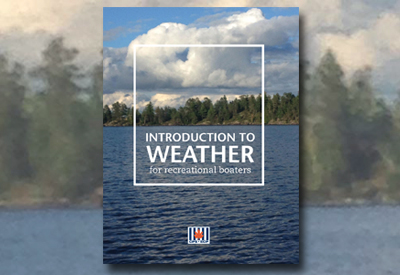Learn weather safety with the new CPS-ECP Weather Course

January 4, 2016
Submitted by the CPS-ECP: Dorit Girash, AP, Windsor Power and Sail Squadron Chair, CPS-ECP Weather Committee
We have developed a brand new weather course which is very specific to the Canadian boating environment. It provides the knowledge and seamanship advice to help you have safe, enjoyable boating experiences in and around Canadian waters. We’ve collaborated with our colleagues at Environment Canada and United States Power Squadrons to give you the most poignant information available.
It is an “Introductory” course because it gives you the foundation for boating in and around Canadian waters. It also prepares you to develop greater expertise if you subsequently decide to take one or more of our regional or specialty seminars (see below). Although the study of weather (Meteorology) is a science, and sciences can have complicated concepts, this new course is presented with hundreds of excellent illustrations that help you have “aha” moments to make weather phenomena not only understandable, but interesting and exciting. And some of us (OK – call us “nerds”) can go beyond the text and explore some brand new fascinating concepts such as the role of high energy cosmic rays originating from exploding stars far across the galaxy to the lightning that occurs in our atmosphere about four million times each day. And what does it mean that thunderstorms produce antimatter?
The “Intro” course begins with the basics of the fluid that is the atmosphere and how the sun’s differential heating of the earth’s surface affects all weather.
• We look extensively at winds and waves. For example:
• Why do land-based wind forecasts seldom match what we experience on the open water?
• Why do winds become stronger as they pass through a narrow channel?
• What causes the turbulence at the base of cliffs?
• What are sea breezes and why are those coming into city marinas so much stronger than those in the outskirts?
• What are “swells”? Rip currents? Longshore currents?
Section 3 explores the ways that moisture can affect our boating: fog and precipitation.
• What is fog? What factors cause it to develop? What/when/how does it dissipate?
• We then move on to the clouds – what forms them?
• What do they tell us about current and future weather?
Of course, we have to thoroughly investigate storms – thunderstorms, tornadoes, and yes, hurricanes.
• What are microbursts and why are they so dangerous?
• Is there any way to survive thunderstorms, tornadoes, or hurricanes in open water?
• What about waterspouts?
And then the “Big Picture”: the systems within which our boating weather develops.
• Why do we hear so much about jet streams?
• What do those big letters – “L” and “H” mean to us boaters? And why do we so often see those triangle-like configurations of warm and cold fronts?
• What are the “Witches of November” and why did so many vessels sink on or around November 10th ?
• Why should we worry about El Niño?
• How does global warming affect boating weather?
And finally, the services available to us to provide us with information.
• Canadian, U.S, and other weather services for mariners.
This course was designed with the adult learner in mind. We adults learn differently than the youngsters. We are not linear or rote learners; we bring to the classroom a rich repertoire of knowledge and experience and we learn best when we can integrate new information into that network of experiential knowledge. And so, in this course, we apply weather concepts to actual or virtual boating experiences. There are no closed-book, memory-work exams; instead, for those who wish to receive CPS-ECP course credit, there are two take-home assignments only. And, if you just wish to sit in class and listen, that’s OK. No one will pressure you to take the course for credit (but you will still need to pay the same tuition).
And, as we learn to accommodate more of the changing realities of education in the age of the internet, some Squadrons may wish to offer the course in “chunks” – as separate seminars for those folks interested in specific – but not all – topics. Please email me at dgirash@cogeco.ca if you would like to discuss this.
The text is available as either an e-book or a printed book. You will also receive a Supplemental Workbook containing review and discussion questions for each section, as well as the two take-home assignments which may be completed for course credit. An Instructor’s Guide is also available online.
Now that the bulk of the work for the main course has been completed, your Weather Committee is busily working on the Regional and Specialty Seminars:
• Great Lakes Weather
• East Coast Weather
• West Coast Weather
• Southern Hemisphere Weather
• Ocean Weather
• On-board Forecasting
So, my dear boating colleagues, do take advantage of the great learning opportunities that we have developed for you to have the safest and most enjoyable boating experiences possible.
KNOWLEDGE IS POWER.
Learn how to anticipate and avoid heavy advection fogs, never get caught in a thunderstorm, and boat safely in perfect (well, maybe “almost perfect”) weather!
Register today:
http://www.boatingcourses.ca/course-descriptions/introduction-weather-recreational-boaters





























